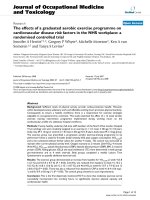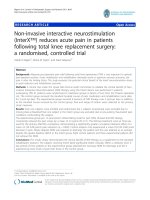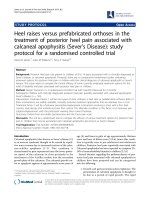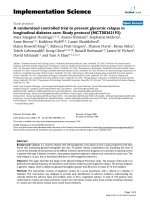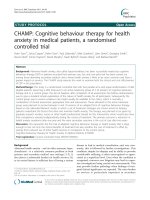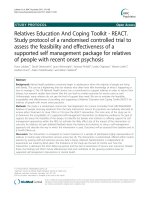Delivering early care in diabetes evaluation (DECIDE): A protocol for a randomised controlled trial to assess hospital versus home management at diagnosis in childhood diabetes
Bạn đang xem bản rút gọn của tài liệu. Xem và tải ngay bản đầy đủ của tài liệu tại đây (286.59 KB, 7 trang )
Townson et al. BMC Pediatrics 2011, 11:7
/>
STUDY PROTOCOL
Open Access
Delivering early care in diabetes evaluation
(DECIDE): a protocol for a randomised controlled
trial to assess hospital versus home management
at diagnosis in childhood diabetes
Julia K Townson1*†, John W Gregory2†, David Cohen3, Sue Channon4, Nicola Harman5, Justin H Davies6,
Justin Warner7, Nicola Trevelyan6, Rebecca Playle1, Michael Robling1, Kerenza Hood1, Lesley Lowes8†
Abstract
Background: There is increased incidence of new cases of type 1 diabetes in children younger than 15 years. The
debate concerning where best to manage newly diagnosed children continues. Some units routinely admit
children to hospital whilst others routinely manage children at home. A Cochrane review identified the need for a
large well-designed randomised controlled trial to investigate any significant differences in comprehensive short
and long-term outcomes between the two approaches. The DECIDE study will address these knowledge gaps,
providing high quality evidence to inform national and international policy and practice.
Methods/Design: This is a multi-centre randomised controlled trial across eight UK paediatric diabetes centres.
The study aims to recruit 240 children newly diagnosed with type 1 diabetes and their parents/carers. Eligible
patients (aged 0-17 years) will be remotely randomised to either ‘hospital’ or ‘home’ management. Parents/carers of
patients will also be recruited. Nursing management of participants and data collection will be co-ordinated by a
project nurse at each centre. Data will be collected for 24 months after diagnosis; at follow up appointments at 3,
12 and 24 months and every 3-4 months at routine clinic visits.
The primary outcome measure is patients’ glycosylated haemoglobin (HbA1c) at 24 months after diagnosis.
Additional measurements of HbA1c will be made at diagnosis and 3 and 12 months later. HbA1c concentrations
will be analysed at a central laboratory.
Secondary outcome measures include length of stay at diagnosis, growth, adverse events, quality of life, anxiety,
coping with diabetes, diabetes knowledge, home/clinic visits, self-care activity, satisfaction and time off school/
work. Questionnaires will be sent to participants at 1, 12 and 24 months and will include a questionnaire,
developed and validated to measure impact of the diagnosis on social activity and independence. Additional
qualitative outcome measures include the experience of both approaches by a subgroup of participants (n = 30)
and health professionals. Total health service costs will be evaluated. A cost effectiveness analysis will assess direct
and indirect health service costs against the primary outcome (HbA1c).
Discussion: This will be the first randomised controlled trial to evaluate hospital and home management of
children newly diagnosed with type 1 diabetes and the findings should provide important evidence to inform
practice and national guidelines.
Trial registration number: ISRCTN: ISRCTN78114042
* Correspondence:
† Contributed equally
1
South East Wales Trials Unit (SEWTU), Department of Primary Care & Public
Health, School of Medicine, Cardiff University, 7th floor Neuadd Meirionnydd,
Heath Park, Cardiff, CF14 4YS, UK
Full list of author information is available at the end of the article
© 2011 Townson et al; licensee BioMed Central Ltd. This is an Open Access article distributed under the terms of the Creative
Commons Attribution License ( which permits unrestricted use, distribution, and
reproduction in any medium, provided the original work is properly cited.
Townson et al. BMC Pediatrics 2011, 11:7
/>
Background
Across Europe, the incidence of type 1 diabetes in children
younger than 15 years is predicted to rise by 70% between
2005 and 2020 [1]. In some areas of the UK, between 1999
and 2003, the incident rate of newly diagnosed cases ranged from 22.4 - 29.8 per 100,000[1]. Traditionally, most
children diagnosed with diabetes have been admitted to
hospital as part of their initial management but over
recent years there has been a move towards carrying out
initial care from diagnosis in the home.
How children should be managed when newly diagnosed with diabetes is still strongly debated. Some units
routinely admit all children to hospital, whilst others
routinely manage children at home [2,3]. For some children, it is necessary to admit them to hospital due to
clinical presentation, for example, for intravenous therapy if acidotic, (approximately 25% of children are
acidotic at diagnosis). However, if children are not
acutely ill at diagnosis, they can be managed safely in
the community [3,4].
There is no high quality evidence concerning whether
hospital admission or home management from diagnosis
in children who are clinically well is different in terms
of physical, psychological, social, and economic outcomes [5,6]. Indeed, a recent Cochrane Review[7] of this
topic could draw no conclusions due to the very small
number and low quality, or limited applicability, of studies. Although home management is supported as a
safe, effective alternative to hospitalisation [3,8-10] studies have commonly been retrospective [5] with little
account taken of any biases that may affect outcomes
[3], and based on relatively small samples often from
single centres [6].
There are also differing interpretations of home management, ranging from complete avoidance of hospitalisation [3] to 72 hours in hospital [8]. The study by
Dougherty et al [8] was the only quality trial identified
in the Cochrane review of home versus hospital management of type 1 diabetes in children [7] but did not
strictly address the research question as children in the
intervention group (n = 32) were also hospitalised for a
total of 70 days. Studies examining cost effectiveness,
mainly in the USA and Canada, suggest either cost
reduction from outpatient management or no significant
difference in costs between home and hospital management [8] but other outcomes need to be taken into
account. For example, if either arm is found to reduce
subsequent readmissions and result in improved glycaemic control, if sustained, this will have positive implications in relation to the reduced risk of diabetes related
complications in later life[11]. These issues need to be
examined over time, not merely to assess cost effectiveness but, more importantly, to determine the effect of
Page 2 of 7
home management and hospitalisation on patients’ long
term health and well being.
A recent empirical qualitative study [4] explored parents’ experience of having their child managed at home
from diagnosis and identified that, although parents
experienced an initial grief response to the diagnosis
similar to that usually associated with bereavement [12],
they had a positive experience of home management.
Parents believed that, because home management
allowed them to deal with situations that occurred
within the framework of their everyday life, the relative
normality of this helped them feel more ‘in control’ of
the situation to enable them to cope more effectively
and feel less anxious. Surprisingly, although parents of
children hospitalised at diagnosis have been found to
experience, for example, remarkably high rates of posttraumatic stress symptoms [13] or distress due to their
child’s hospitalisation [14], no work has explored parents’ experiences of initial hospitalisation or children’s
experiences of either approach.
Furthermore, little emphasis has been placed on psychosocial outcomes [6] or comparison of psychological
outcomes from home management and hospitalisation.
Improved pyschological well-being of parents and their
affected child from diagnosis could also have a positive
impact on diabetes control and subsequent engagement
with the diabetes team. As Clar et al [7] emphasised,
there is a need for a large, well- designed RCT to investigate whether there are significant differences in comprehensive short and long-term outcomes between the
two approaches. The DECIDE multi-centred RCT will
address these gaps in the current knowledge base by
building on the programme of work by Lowes et al
[2,11,12], providing high quality evidence on which to
base decisions about the environment (home or hospital) where treatment should be initiated for children
with newly diagnosed type 1 diabetes, potentially making
a difference to the lives of children with type 1 diabetes
and their parents.
Methods/Design
Ethical and governance approval
Multi-centre approval has been granted by Research
Ethics Committee for Wales (07/MRE09/59). Sitespecific approval has been granted by local RECs at all
trial sites and all participating Acute Trust Research and
Development Departments.
Design
This is a multi-centre randomised controlled trial, for
children aged 0-17 years who have been newly diagnosed with type 1 diabetes and their parents. Participants will be randomised to receive either hospital
Townson et al. BMC Pediatrics 2011, 11:7
/>
management (minimum of 3 overnight stays in hospital)
or home management (no overnight stays in hospital).
Clinic and patient selection
This study will be carried out in eight UK paediatric
diabetes centres. Criteria for selection are based on size
of the paediatric diabetes centres (a minimum of
approximately 30/40 newly diagnosed patients per year)
and geographical placement, to ensure balanced distribution of socio-economic factors across the UK. The
paediatric diabetes centres will be based within NHS
secondary care (paediatric wards and outpatient clinics).
The paediatric diabetes team at each centre will comprise at least one consultant paediatrician with an interest in diabetes, a paediatric diabetes nurse and a
paediatric dietician. Collaboration and recruitment is
already agreed with teams in the UK from Cardiff,
Southampton, Hull, Liverpool, Cambridge, Belfast, Newcastle and Nottingham.
Within each centre, a study-specific Project Nurse will
be employed, whose role will be to co-ordinate nursing
management of participants and data collection.
Inclusion and exclusion criteria
Participants will only be entered into the trial if they
meet the following inclusion and exclusion criteria
(see Table 1).
Recruitment
Patients (aged ≥8 years) and all parents/carers of
patients (aged 0-17 years), will be given information
about the study by a member of the clinical team to
read whilst in the assessment unit/paediatric ward. They
will have time to consider the study while blood tests
are taken to confirm the clinical diagnosis.
Page 3 of 7
Randomisation
Once informed consent/assent is obtained, patients will
be remotely randomised using an automated telephone
system operational 24 hours a day. Patients will be randomised to either ‘Home Management’ or ‘Hospital
Management’.
Randomisation will be stratified by centre and
balanced using randomly chosen permuted blocks. The
randomisation ratio is 1:1
Trial procedures
Process of care for all patients
Hospitalised and home-managed children and their parents will receive education and support from the project
nurse and local paediatric diabetes team at each centre.
Both cohorts will receive written information about diabetes, and a structured diabetes education programme.
Education programmes, including dietary advice, will be
standardized across centres as far as possible, but it is
anticipated that minimal variability will be found concerning the educational content of programmes currently used at individual centres. Children will be
commenced on an insulin regimen and delivery system
that are deemed appropriate by teams at individual centres, and will be asked to undertake three to four blood
glucose measurements a day before meals for the first
4 weeks of the study. All families will be given an
appointment to attend the next appropriate diabetes
clinic, will receive continued support from health professionals through telephone contact and clinic visits,
and will be able to access help and advice out of office
hours. Throughout the study, the paediatric diabetes
team at each centre will comprise at least one consultant paediatrician, a paediatric diabetes nurse and a paediatric dietician.
Table 1 Participant inclusion/exclusion criteria
Inclusion criteria (Children)
Exclusion criteria (Children)
1. Children aged 0 - 17 years old
1. Children with ketoacidosis at presentation requiring treatment with
intravenous insulin and fluids
2. Newly diagnosed type 1 diabetes (using recognised standard
diagnostic criteria) who are clinically well at presentation
2. Children with a co-existing chronic disorder (e.g. cystic fibrosis) which
will impact significantly on blood glucose control
3. Written informed consent given by child and assent from child
3. Children with Type 2 diabetes
4. Able to fill out study material (children aged ≥8 years old
4. Children with Maturity Onset Diabetes of the Young (MODY)
5. Written informed consent by parent(s)/carer
5. Children with an uncertain diagnosis
6. Parent/carer able to fill out study material
6. Children who are under the care of the local authority
7. Children whose home circumstances are assessed as being unsuitable
for home management
8. Children who require hospitalisation for reasons other than their
diagnosis
9. Children who have a sibling with existing Type 1 diabetes
10. Children who will begin treatment on a Continuous Subcutaneous
Insulin Infusion (CSII)
Townson et al. BMC Pediatrics 2011, 11:7
/>
To assist centres to deliver the study, a manual was
developed providing guidance in key areas such as initial
diagnosis, recruitment, home management and hospital
management.
Home management
The study will use a pragmatic approach to home management in order to accommodate the individual needs
of participating centres. It would be inappropriate to
undertake the study using one specific model that, if
found to be beneficial, could not be subsequently
adopted by centres due to, for example, differing insulin
regimens (e.g. twice daily insulin or multiple injection
regimens) or particular geographical needs (e.g. centres
covering large rural areas).
The standard elements of home management that will
be common to all participating centres are:
- Discharge home on the day of diagnosis with no
overnight admission to hospital
- All treatment, education and support will be delivered at home or on an outpatient basis (attending
ward/clinic for no longer than 2 hours for supervision
of injections as necessary according to local need) for
a minimum of three days (at least six supervised
injections)
- Dietetic education will be provided at home or as
outpatients, with continued dietetic support provided
in clinic.
Hospitalisation
Children will be admitted to hospital at diagnosis for a
minimum of three nights (receiving at least six supervised injections while hospitalised). During their inpatient stay, families will receive treatment, education and
support in the ward environment. The paediatric dietician will provide dietetic education to the child and
family on the ward, and provide continued dietetic support at clinic visits. The project nurse at each centre
will undertake at least one home visit (on or soon after
the day of discharge at a time when insulin is due), with
home visits continued as required according to the
needs of individual families.
Frequency & duration of follow-up
There will be three follow up appointments carried out
at 3, 12 and 24 months as part of the participant’s routine clinic visits.
Questionnaires will be sent to parents, and age-appropriate questionnaires to children, at 1, 12 and 24 month
intervals.
Page 4 of 7
Data collection
Data concerning length of stay at diagnosis, glycaemic
control (HbA1c), growth (weight, height, BMI), readmissions, adverse events (e.g. hypoglycaemia), home and
clinic visits, school attendance, self-care activity and parents’ time off work and travel costs (in relation to the
child’s diabetes) will be collected at clinic visits for
24 months after diagnosis. This will be at routine visits,
which take place every 3-4 months.
There will also be standardised follow up visits at 3,
12 and 24 months. At diagnosis and at months 3, 12
and 24, extra blood from the initial sample taken to
measure the patient HbA1c (glycosylated haemoglobin)
level, will be taken and sent to a centralised laboratory
(Diabetes Research Network Wales Laboratory,
Llandough Hospital) for measurement of HbA1c concentrations. See Table 2.
Primary & secondary outcomes
The primary outcome measure for the trial is HbA1c of
patients at two years following diagnosis. HbA1c was
selected because it is an objective measure of glycaemic
control used to inform clinical practice and national and
international policies and guidelines.
The secondary outcome measures for patients include
growth, adverse events, psychological assessment of quality of life, coping with diabetes, diabetes knowledge, satisfaction and time off school. Secondary outcome measures
for parents include anxiety, coping with diabetes, diabetes
knowledge, satisfaction and time off work. Mean HbA1c
at 3 and 12 months will be used to assess shorter term
intervention effects. Additional qualitative outcome measures will be taken from health professionals’ experience
of both approaches to care. Finally, total health service
costs, including hospitalisation, home/clinic visits and use
of other NHS resources will be evaluated.
Quality of life measures to be used will be adapted
from:- Issues in Coping with IDDM Scale - parent version
[15]
- Spielburger Anxiety Scale (short version) [16]
- Diabetes Knowledge Scale - parent version [17]
- Quality of Life (PedsQol) - parent proxy version
[18]
- Issues in Coping with IDDM Scale - child version
[15]
- Diabetes Knowledge Scale - child version [17]
- Quality of Life (PedsQol) - child version [18]
In addition, there is no available validated measure of
the impact of a diagnosis of diabetes on social activity
Townson et al. BMC Pediatrics 2011, 11:7
/>
Blood sample - for HbA1c analysis at central
laboratory
follow-up time point using ANCOVA. Baseline HbA1c
will be included as a covariate. These analyses will be
corrected for any clustering of outcomes within a clinic.
Secondary outcomes analyses will compare the two
groups using repeated measures ANOVA. These analyses will also be corrected for any clustering of outcomes within a clinic and baseline levels. Secondary
analysis of the primary outcome using repeated measures ANOVA will be carried out using the 3, 12 and
24 month HbA1c values for the two groups and will
also involve a more detailed exploratory analysis of the
impact of clinic level factors on HbA1c outcome using a
two level linear multi-level regression model.
Follow up CRF
Qualitative Analysis
Parent Questionnaire
Qualitative data analysis is an on-going rather than discrete activity. Data from the qualitative interviews
undertaken with a subgroup of children older than
8 years of age and parents will be subject to thematic
analysis, which comprises a number of steps: 1) interviews will be audio-recorded and transcribed verbatim,
2) patterns of experience will be listed, which may arise
from direct quotes or the paraphrasing of common
ideas, 3) data relating to the already classified patterns
will be identified, 4) related patterns will be combined
and catalogued into sub-themes, and 5) themes will be
developed. Themes that emerge from participants’
accounts will be coded and subsequently collated to
form a comprehensive picture of their collective experience. It is anticipated that this will provide a detailed,
in-depth insight into the thoughts and experiences of
the participants. Data will be explored to allow identification and comparison of similarities and differences
between cases and between the two arms of the study.
The analytical process will be undertaken in a way that
ensures that the integrity of the original document is
kept intact.
Table 2 Data Collection
Month
0
Forms/samples
Diagnosis, consent and randomisation
Baseline case report form (CRF)
Blood sample - HbA1c analysis at central
laboratory
1
Parent Questionnaire
Child Questionnaire
3
Blood sample - for HbA1c analysis at central
laboratory
Follow up CRF
12
Child Questionnaire
24
Blood sample - for HbA1c analysis at central
laboratory
Follow up CRF
Parent Questionnaire
Child Questionnaire
Throughout 24 month
follow up
up to 60 months
Page 5 of 7
CRF completion and data collection at
routine follow up visits approximately every
3-4 months.
HbA1c measurements
(taken and analysed at local Hospital)
and independence. Therefore, a Social Activity and
Independence Questionnaire (SAIQ) will be developed
and validated for use as a secondary outcome measure.
The development phase will include item generation
through interviews with children and parents living with
diabetes and those items will be included for all participants as part of the main outcome questionnaires with
parents and children.
Sample size
Cost Effectiveness Analysis
In order for a randomised trial to have 80% power to
detect an effect size of 0.4 (difference in mean HbA1c of
0.5% with an SD of 1.3% [7]) at a 5% significance level, a
total of 200 patients would be required. To allow for
loss to follow up of 17%, it is aimed to recruit 240 children. A previous study in Canada which evaluated reducing the amount of in-patient time at diagnosis showed
a difference of 0.7% in mean HbA1c at two years [8].
Loss to follow up for the primary outcome of HbA1c
should be small, as all of these patients will be attending
clinic on a regular basis where HbA1c is monitored for
clinical purposes.
A cost effectiveness analysis will assess direct (management at diagnosis) and indirect (subsequent) health service costs against the primary outcome (HBa1C). All
NHS resource use, including inpatient admissions, insulin use, contacts with the diabetes team, investigations,
attendances at accident and emergency departments,
ambulance journeys, contacts with general practitioners
and other health professionals will be monitored prospectively and valued by standard methods [19] using
national unit costs supplemented where necessary by
cost information from participating centres. Non-NHS
costs such as parental time off work and travel are also
being assessed but will be reported separately. Cost
effectiveness results will be reported in the form of an
incremental cost effectiveness ratio unless either form of
patient management dominates (lower cost with greater
effect). A series of one-way sensitivity analyses will test
Analysis
Main analysis
Primary analysis will be intention to treat and will compare HbA1c between the two groups at the 24 month
Townson et al. BMC Pediatrics 2011, 11:7
/>
the sensitivity of the conclusions to changes in the main
base case assumptions used.
Given the multiple objectives of a management at diagnosis service for children and the consequent importance
of the secondary outcomes in this study (psychological
adjustment, coping, adaptation to diagnosis), a costsconsequences analysis will also be undertaken.
Discussion
The primary objective of this research is to determine
whether there are significantly different outcomes for
children with newly diagnosed type 1 diabetes who are
clinically well, when they are either admitted to hospital
or managed at home for initiation of insulin treatment
and education of child and family.
This trial poses various challenges, one of which concerns the recruitment of patients. Recruitment takes
place almost concurrently with the diagnosis and parents and children may find it difficult to think about
participating in a study at this distressing time. It will be
down to the skill and expertise of the DECIDE project
nurses, and members of the multi-disciplinary paediatric
diabetes teams, to explain the trial to potential participants, to maximise recruitment.
Another challenge of the trial is that many participating centres may not have had any previous experience
of providing home management. This has necessitated
the development of a dedicated DECIDE manual to
assist centres through the process. This outlines for the
first time, the minimum requirements of safe, homebased care from diagnosis which could be equally deliverable in a variety of differing clinical services.
This will be the first RCT to evaluate the difference,
if any, in terms of clinical and psychological outcomes
of patients managed from diagnosis in the differing settings. It is anticipated that outcomes from this trial will
provide evidence to inform national and international
guidelines (e.g. NICE, ISPAD) concerning how best
to initially manage children diagnosed with type 1
diabetes.
Acknowledgements
The authors acknowledge with thanks the trial funders Diabetes UK. The
South East Wales Trials Unit is funded by the Wales Assembly Government
through the Wales Office of Research and Development and the authors
gratefully acknowledge SEWTU’s contribution to study implementation. The
authors acknowledge the contribution of all the principal investigators and
the clinical teams at each of the 8 trial sites; the project nurses who have
been providing support to the trial; the patients and carers participating in
the trial; the stakeholders and others who have contributed.
Author details
South East Wales Trials Unit (SEWTU), Department of Primary Care & Public
Health, School of Medicine, Cardiff University, 7th floor Neuadd Meirionnydd,
Heath Park, Cardiff, CF14 4YS, UK. 2Department of Child Health, School of
Medicine, Cardiff University, Heath Park, Cardiff, CF14 4XN, UK. 3Health
Economics and Policy Research Unit, University of Glamorgan, Pontypridd,
1
Page 6 of 7
CF37 1DL, UK. 4Paediatric Psychology Department, Children’s Centre, St
David’s Hospital, Cardiff, CF11 9XB, UK. 5Medicines for Children Research
Network Clinical Trials Unit, University of Liverpool, Liverpool, L12 2AP, UK.
6
Child Health Directorate, Southampton University Hospital Trust, Tremona
Road, Southampton, SO16 6YD, UK. 7University Hospital of Wales, Heath Park,
Cardiff, CF14 4XN, UK. 8School of Nursing and Midwifery Studies, Cardiff
University, Cardiff, CF24 0AB, UK.
Authors’ contributions
LL and JG are the joint principal investigators and guarantors of the study in
its entirety. LL and JG were responsible for developing the research question
and study design, and implementation of the study protocol. JT and NH
were responsible for trial management. JT, LL and JG were responsible for
drafting the manuscript. DC was responsible for designing the economic
evaluation. SC was responsible for advising on study design and developing
the SAIQ. JD, JW, MR and NT contributed to the study design and
implementation.RP and KH were responsible for the statistical design and
are the study statisticians. All those listed as authors were responsible for
reading, commenting upon, and approving the final manuscript.
Competing interests
The authors declare that they have no competing interests.
Received: 22 November 2010 Accepted: 19 January 2011
Published: 19 January 2011
References
1. Patterson CC, Dahlquist GG, Gyurus MD, Green A, Soltesz G, the EURODIAB
Study Group: Incidence trends for childhood type 1 diabetes in Europe
during 1989 - 2003 and predicted new cases 2005 - 20: a multicentre
prospective registration study. The Lancet 2009, 373(9680):2027-2033.
2. Lowes L, Davis R: Ambulatory care of children with newly diagnosed
diabetes. In Innovations in Paediatric Ambulatory Care - A Nursing
Perspective. Edited by: Glasper EA, Lowson S. MacMillan Press Ltd,
Hampshire UK; 1998:212-227.
3. Swift PGF, Hearnshaw JR, Botha JL, Wright G, Raymond NT, Jamieson KF:
A decade of diabetes: keeping children out of hospital. British Medical
Journal 1993, 307:96-98.
4. Lowes L, Lyne P, Gregory JW: Childhood diabetes: parents’ experience of
home management and the first year following diagnosis. Diabetic
Medicine 2004, 21:531-538.
5. Lowes L, Gregory JW: Management of newly diagnosed diabetes - home
or hospital. Archives of Disease in Childhood 2004, 89:934-937.
6. Charron-Prochownik D, Maihle T, Siminerio L, Songer T: Outpatient versus
inpatient care of children newly diagnosed with IDDM. Diabetes Care
1997, 20(4):657-660.
7. Clar C, Waugh N, Thomas S: Routine hospital admission versus outpatient or home care in children at diagnosis of type 1 diabetes
mellitus. Cochrane Database of Systematic Reviews 2007 2003, 2: CD004099.
8. Dougherty GE, Soderstrom L, Schiffrin A: An economic evaluation of home
care for children with newly diagnosed diabetes. Results from a
randomised control trial. Medical Care 1998, 36(4):586-598.
9. Chase HP, Crews KR, Garg S, Crews MJ, Cruikshanks KJ, Klingensmith G,
Gay E, Hamman RF: Outpatient management vs in-hospital management
of children with new-onset diabetes. Clinical Pediatrics 1992, 450-456.
10. Lee PDK: An outpatient-focused program for childhood diabetes: design,
implementation and effectiveness. Texas Medicine/The Journal 1992,
88(7):64-68.
11. Diabetes Control and Complications Trial Research Group: The effect of
intensive treatment of diabetes on the development and progression of
long-term complications in insulin dependent diabetes mellitus. The New
England Journal of Medicine 1993, 329(14):977-986.
12. Lowes L, Gregory JW, Lyne P: Newly diagnosed childhood diabetes:
a psychosocial transition for parents? Journal of Advanced Nursing 2005,
50(3):253-261.
13. Landolt MA, Ribi K, Laimbacher J, Vollrath M, Gnehm HE, Sennhauser FH:
Brief report: Posttraumatic Stress Disorder in parents of children with
newly diagnosed type 1 diabetes. Journal of Pediatric Psychology 2002,
27(7):647-652.
14. Seppanen SM, Kyngas HA, Nikkonen MJ: Coping and social support of
parents with a diabetic child. Nursing and Health Sciences 1999, 1:63-70.
Townson et al. BMC Pediatrics 2011, 11:7
/>
Page 7 of 7
15. Kovacs M, Iyengar S, Goldston D, Obrosky DS, Stewart J, Marsh J:
Psychological functioning among mothers of children with insulin
dependent diabetes mellitus: a longitudinal study. Journal of Consulting
and Clinical Psychology 1990, 58(2):189-195.
16. Marteau TM, Bekker H: The development of a six-item short form of the
state scale of the Spielberger State-Trait Anxiety Inventory. British Journal
of Clinical Psychology 1992, 31:301-306.
17. Beeney LJ, Dunn SM, Welch M: Measurement of diabetes knowledge the development of the DKN scales. In Handbook of Psychology and
Diabetes. Edited by: Bradley C. UK: Harwood; 1994:159-189.
18. Varni JW, Burwinkle TM, Jacobs JR, Gottschalk M, Kaufman F, Jones KL: The
PedsQL in type 1 and type 2 diabetes: reliability and validity of the
Pediatric Quality of Life Inventory Generic Core Scales and type 1
Diabetes Module. Diabetes Care 2003, 26(3):631-7.
19. Drummond MF, O’Brien B, Stoddard GL, Torrance GW: Methods for the
Economic Evaluation of Health Care Programmes. 3 edition. Oxford: Oxford
University Press; 2005.
Pre-publication history
The pre-publication history for this paper can be accessed here:
/>doi:10.1186/1471-2431-11-7
Cite this article as: Townson et al.: Delivering early care in diabetes
evaluation (DECIDE): a protocol for a randomised controlled trial to
assess hospital versus home management at diagnosis in childhood
diabetes. BMC Pediatrics 2011 11:7.
Submit your next manuscript to BioMed Central
and take full advantage of:
• Convenient online submission
• Thorough peer review
• No space constraints or color figure charges
• Immediate publication on acceptance
• Inclusion in PubMed, CAS, Scopus and Google Scholar
• Research which is freely available for redistribution
Submit your manuscript at
www.biomedcentral.com/submit
